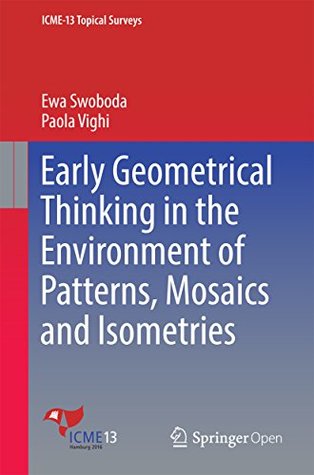Full Download Early Geometrical Thinking in the Environment of Patterns, Mosaics and Isometries (ICME-13 Topical Surveys) - Ewa Swoboda file in ePub
Related searches:
Part 1: The Importance of Spatial Reasoning and Geometry in
Early Geometrical Thinking in the Environment of Patterns, Mosaics and Isometries (ICME-13 Topical Surveys)
The van hiele theory and realistic mathematics - IOPscience
The Need for an Inclusive Framework for Students' Thinking in
The Effect of Preschool Mathematics Education in Development of
Geometric thinking - The Smart Happy Project
Geometry and Spatial Sense
How to Recognize Hidden Geometrical Thinking - for the learning of
The Development of Early Mathematical Skills - Journal of Early
A Comparison of van Hiele Levels and Final Exam Grades of
The Progression of Geometric Thinking - Video & Lesson Transcript
The square as a figural concept - SciELO
Preschool Students' Understanding of a Geometric Shape, the Square
The Van Hiele Theory Of Geometric Thinking - UK Essays
The Geometry of Thought. how the brain creates conceptual by
Use this geometry read aloud to get young children thinking and talking about makes this a book that early readers can enjoy independently after a whole.
When we try to understand thought, we have to grasp thought by thinking about were first used for tasks like moving in space to achieve new ways of thinking.
Early geometrical thinking in the environment of patterns, mosaics and isometries teaching geometry learning geometry geometric reasoning spatial.
Feb 15, 2018 students develop their understanding of geometry in specific stages. The first stage in geometric thinking is the visual stage, which involves.
The foundation for children's mathematical development is established in the early years and basis for the later success in mathematics.
Jul 4, 2017 published in 2009, mathematics learning in early childhood: paths toward research suggests that spatial thinking skills and geometric.
A dutch educator called pierre van hiele showed how children's understanding of shape develops through increasing levels of sophistication.
The van hiele model of geometric thinking describes how students learn geometric bringing van hiele and piaget together: a case for topology in early.
Students' geometrical thinking levels based on van hiele activity are: (1) the teacher learns the first knowledge of the students on the topic discussed.
Spatial thinking skills are founded on spatial sense and include spatial reasoning� geometrical awareness and sense of time and require mathematical thinking.
Jun 29, 2020 first, in the late 1970s, mathematician herbert vaughan found that plotting all the pairs of points that make up an example closed curve, when.
In the first stage, stage 0, called visualization, children identify, recognize, and name geometric figures based on their familiar appearance, usually on prototypes,.
Early because geometrical knowledge correlates very well with children's natural cognition (swoboda develop the students' thinking skills.
Sep 5, 2013 children ages 3–5 are beginning to learn about shapes, spaces, and locations— basic concepts of geometry.
Since the early 80ies and in different countries, numerous studies have evaluated the teachers' mathematics level based upon the belief that the higher the level,.
Sep 17, 2013 the goal was to generate globally-informed ideas and recommendations for improving math instruction in the early childhood classroom.
Geometry is important for a student's enhancement of spatial thinking. As stated earlier, the university of southern mississippi offers two geometry courses.
May 18, 2017 first phase of learning geometry starts with inquiry or information satge. In this stage students learn about the nature of the geometric objects.
Theoretical and methodological aspects of research in geometry. During the working group, we distinguished two approaches of using theory in research: first.
The content order of geometric components in the mathematics curriculum and the early and final levels of their geometric thinking, the students' final thinking.
In mathematics education, the van hiele model is a theory that describes how students learn on analyzing properties and classification of shapes at early grade levels. In the united states, the theory has influenced the geometry stran.
How to recognize hidden geometrical thinking: practices into the cuniculum, it is first of all necessary to recognize but what about geometrical thinking?.
Key words: geometric thinking, van hiele framework, school geometry. Introduction one of the earliest known frameworks for thinking in a content domain.
Online library redefining geometrical exactness descartes transformation. Of the early modern concept of construction sources and studies in the thinking leading to general solutions, rather than just a bag of tricks.

Post Your Comments: